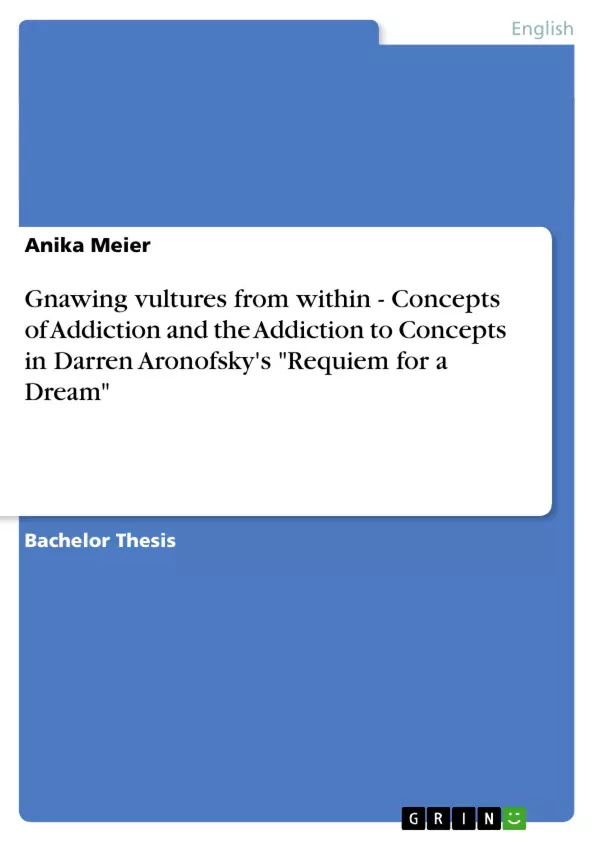Die Arbeit ist zwar innerhalb der Amerikanistik geschrieben, hat jedoch auch einige filmwissenschaftliche Elemente. Ich habe darin den Zusammenhang von Drogen innerhalb unserer modernen Gesellschaft untersucht (immer mit Hinblick auf den Roman/den Film "Requiem for a Dream") sowohl in sozio-kultureller als auch philosohischer und psychologischer Sicht.
Wer den Film kennt, wird wissen, dass Abhängigkeit hierbei jedoch eine weitere Dimension durchbricht, angetrieben durch das parallel Storytelling der Geschichte von Sara Goldfarb.
Die Geschichte unterscheidet sich zunehmend von anderen "Drogenfilmen", sie etabliert eine Ebene von Abhängigkeit, die weit über die übliche Nahaufnahme der Nadel hinausgeht.
Sie stellt ein Epigramm unserer Gesellschaft dar ist und ein sehr spannendes und lehrreiches Thema!
Inhaltsverzeichnis (Table of Contents)
- Preface
- The Intoxicated Screen
- Deranging the Models of Addiction: Requiem for a Dream
- Sclerotic Veins and a Pound of Pure: Aronofsky's Use of Concepts of Addiction
- Parallel Story Telling: Sara Goldfarb and the Other Addiction
- Leisure Wear and Matching Luggage: Human Failure in the Modern Age
- Blurring the Boundaries & Bridging the Gap
- On Contents
- On New Cinema Tendencies
- Societal and Cultural Thresholds
Zielsetzung und Themenschwerpunkte (Objectives and Key Themes)
This paper examines the depiction of addiction in film, focusing on Darren Aronofsky's Requiem for a Dream. It aims to challenge conventional understandings of addiction by exploring the film's portrayal of both material and immaterial forms of addiction, blurring the boundaries of established definitions. The paper analyzes how film contributes to the creation and perpetuation of myths and stereotypes surrounding addiction, particularly within Western culture.
- The cultural construction of addiction and its representation in film.
- The limitations of traditional definitions of addiction.
- The role of film in shaping societal perceptions of addiction.
- The concept of addiction to concepts, as opposed to material substances.
- The exploration of addiction as a symptom of societal failures.
Zusammenfassung der Kapitel (Chapter Summaries)
The Preface introduces the complexities of addiction and the paper's focus on its cinematic representations. The Intoxicated Screen chapter discusses the ambivalent role of film in reflecting and shaping societal perceptions of addiction, highlighting the creation of myths and stereotypes. It analyzes how films have historically depicted addiction, often associating it with violence, social dysfunction, and specific demographic groups. The chapter also mentions the ambiguity of the term "drugs" and its implications. The chapter on Deranging the Models of Addiction: Requiem for a Dream will delve into Aronofsky's film, exploring its depiction of addiction and its impact on the established cultural understanding of the subject. This section will be further broken down into sub-chapters that will delve into the specifics of the film's themes.
Schlüsselwörter (Keywords)
Addiction, film, Requiem for a Dream, cultural studies, societal perceptions, cinematic representation, material and immaterial addiction, myths and stereotypes, modern society, drug culture.
- Citar trabajo
- BA Anika Meier (Autor), 2008, Gnawing vultures from within - Concepts of Addiction and the Addiction to Concepts in Darren Aronofsky's "Requiem for a Dream", Múnich, GRIN Verlag, https://www.grin.com/document/120513



